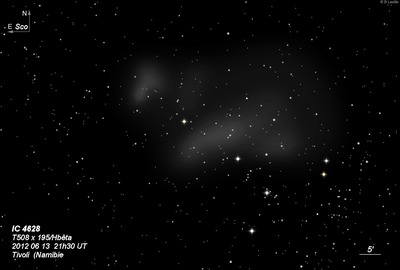
E.E. Barnard discovered IC 4628 between 1892 and 1895 on a plate taken at Lick Observatory. In Lick Publications Vol 11, 1913, Plate 37 he describes: "The coarse cluster in 16h 48m, -40.3° does not seem to be in Dreyer's lists. It is a very interesting object and appears to be connected by a scattering chain of stars, with the cluster [NGC] 6231 south of it. In its northern part is the nebula IC 4628. This was originally discovered on a plate with the Willard lens, but no announcement was made of it. It is a large nebula one half degree in diameter and of irregular form and brightness. A photograph with the 10-inch Bruce telescope at Mount Wilson in 1905 (June 21) shows the irregular group of stars and the nebula very beautifully. There are still fainter portions that extend half a degree to the northeast. The nebulosity, apparently, does not condense about any one of the stars and is probably not actually connected with the cluster." Royal Harwood Frost also found IC 4628 = F. 1148 on a photographic place taken in 1903 at Harvard's Arequipa station and both are credited in the IC.
200/250mm - 8" (7/13/91 - Southern Baja): this is an emission nebula on the north side of a large open cluster Tr 24 = H12. Appears fairly faint, very large, about 30'x10' diameter and clearly elongated E-W. Shows up best with the UHC filter at 83x although visible without a filter. Includes some brighter portions. Also visible in the 16x80 finder with a UHC filter.
400/500mm - 18" (6/12/10): this large HII region is embedded in the northern half of Tr 24, a sprawling 60' cluster just north of NGC 6231. At 108x and UHC filter IC 4628 stood out as a very large, fairly bright glow within Tr 24. The main glow was elongated E-W, roughly 30'x12' with mag 7.2 HD 152723 just off the south side. The northern side has a fairly well-defined edge and a number of mag 8-10 stars are embedded along the southwest and west end of the nebulosity. A fainter extension begins on the east end and extends northeast for ~15', ending in a brighter HII patch (G345.31+01.47) peppered with several stars and involving the infrared cluster [DBS2003] 114.
Notes by Steve Gottlieb